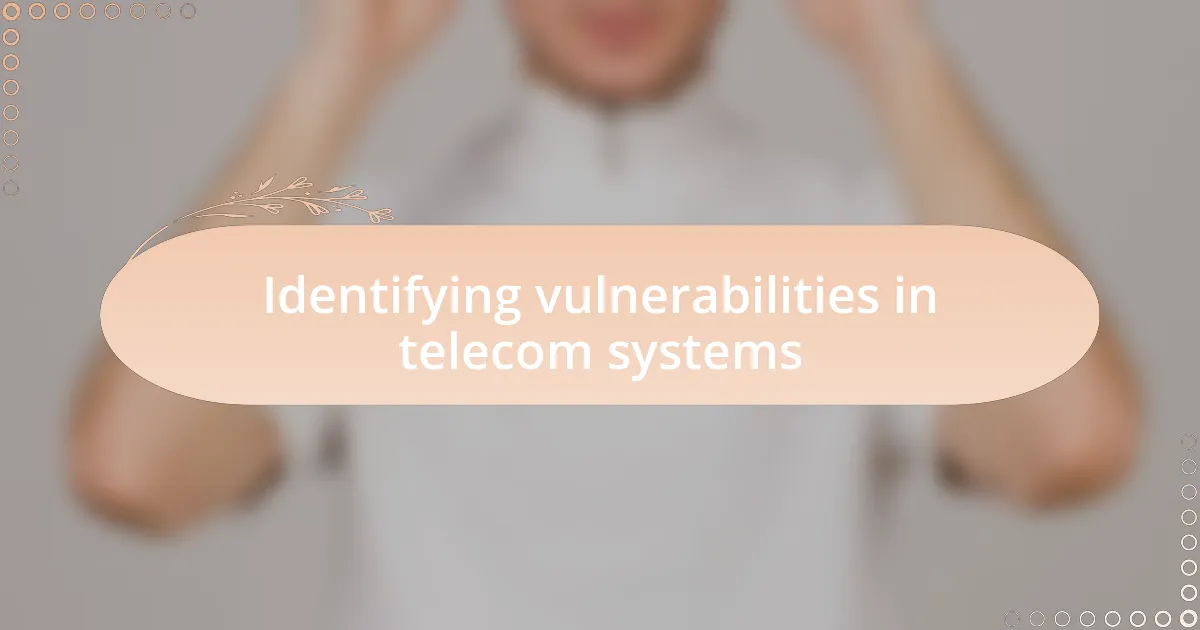Key takeaways:
- Social engineering exploits human psychology, utilizing techniques like phishing, pretexting, and baiting to manipulate trust and urgency.
- Telecommunications technology relies on complex infrastructures that are susceptible to vulnerabilities, both human and technical, making them attractive targets for attacks.
- Recognizing emotional triggers and maintaining security awareness are critical in protecting against social engineering risks.
- Physical access to telecom infrastructure often goes unguarded, highlighting the need for comprehensive security measures that encompass both digital and physical protections.

Understanding social engineering risks
Social engineering risks revolve around the manipulation of human psychology rather than technological vulnerabilities. I can recall an instance when a friendly voice on the phone convinced me to disclose sensitive information, and that’s a stark reminder of how easily trust can be exploited. It raises an important question: How often do we stop to consider whether the person on the other end is genuinely who they claim to be?
These risks thrive on our inherent desire to help and communicate, and that’s where they can be particularly dangerous. I once received an email that appeared urgent, claiming to be from a trusted colleague, urging immediate action. Luckily, a moment of hesitation allowed me to verify the legitimacy, and I realized later how many others might have jumped in without a second thought. Have you ever found yourself in a similar situation, where urgency clouded your judgment?
Understanding these risks involves recognizing the emotional triggers that attackers exploit, often playing on fear or curiosity. I find it chilling when I think about how easy it is for well-crafted messages to stir those feelings. When you’re aware of social engineering tactics, you become more vigilant—and that is a powerful tool in protecting yourself and your organization.

Overview of telecommunications technology
Telecommunications technology involves the transmission of information over distances, utilizing a mix of electronic and optical systems. I remember the first time I used a mobile phone; it dawned on me how something so small could connect me to people across the globe in an instant. This rapid evolution of technology has reshaped not just personal communication but also the way businesses operate, creating a world that is more interconnected than ever.
The backbone of telecommunications lies in various infrastructures, from fiber optic networks to satellite systems, enabling seamless communication for millions. I often reflect on how a simple phone call can cross continents, relying on an intricate web of technology that we often take for granted. Do you ever consider the complex systems working behind the scenes every time you send a text or make a call?
Beyond just voice and messaging services, telecommunications technology is the foundation for data exchange and internet connectivity. I once experienced a brief outage during an important video conference, highlighting how reliant we are on this technology. It raises the question: how much do we really appreciate the technology that keeps our daily communications flowing? Understanding its significance can help us recognize vulnerabilities, especially when it comes to social engineering risks lurking in this interconnected landscape.

Common social engineering techniques
Social engineering often employs techniques that manipulate human psychology rather than exploiting technical vulnerabilities. One common method is phishing, where attackers send seemingly legitimate emails to trick recipients into revealing sensitive information, like passwords. I still remember receiving such an email that looked exactly like a trusted service I used; my heart raced as I realized I almost fell for it.
Another frequent technique is pretexting, where an attacker creates a fabricated scenario to obtain confidential information. For instance, they might impersonate a company executive to request sensitive data from an unsuspecting employee. Reflecting on my own experiences, I find it unsettling how easily people can be convinced to share information just because someone sounds authoritative or genuine.
Lastly, there’s the tactic of baiting, which lures victims into clicking on malicious links or downloading harmful software by offering something enticing. I recall a time when a friend was intrigued by a “free software download” that turned out to be malicious—his computer suffered for weeks due to the infection. How often do we let curiosity or temptation guide our online actions without considering the potential risks?

Identifying vulnerabilities in telecom systems
Telecom systems are prime targets for social engineering attacks, and identifying their vulnerabilities starts with understanding human behavior. I remember a time when I worked on a project that involved updating our network protocols. It struck me how often we overlooked the human element in our security assessments. Why would someone with direct access to sensitive data not be trained to recognize suspicious communications? This lack of awareness can be a significant vulnerability.
In addition to human factors, technical flaws in telecom systems can open the door to social engineering exploits. One instance I encountered involved an outdated software version on a crucial server. It surprised me how many companies still run legacy systems, leaving them exposed to attacks that exploit these weaknesses. Isn’t it ironic how technology advancement often gets overshadowed by complacency?
Lastly, consider how physical access to telecom infrastructure can also lead to vulnerabilities. I remember visiting a remote tower site where security protocols seemed lax. Anyone could have gained access without verification, raising an alarming question: why do organizations often prioritize digital security while neglecting physical safeguards? It’s a clear reminder that comprehensive security must cover all bases—from human factors to technical integrity and physical protection.

Personal experiences with social engineering
Social engineering isn’t just a theoretical risk; I’ve encountered it firsthand. There was a moment when a colleague received a seemingly harmless email from what appeared to be our IT department. The urgency in the message was palpable, demanding immediate action. It turned out to be a fishing expedition, but at that moment, I wondered—how easily could a stress-motivated employee have fallen for it?
During a team meeting, we discussed our experiences with social engineering attempts. One person shared how they received a phone call from someone posing as a vendor, asking for sensitive information under the guise of confirming an order. Hearing their story sparked a mix of disbelief and concern—how many others might let their guard down in a similar situation?
I also recall a time when I attended a security awareness training session. The facilitator illustrated how simple things, like leaving a computer unlocked in a common area, could be an open invitation for a savvy social engineer. Listening to those examples made me reflect on my daily practices. Am I vigilant enough, or do I occasionally let my defenses down? It’s a fine line we walk in maintaining our security awareness in an ever-evolving landscape.